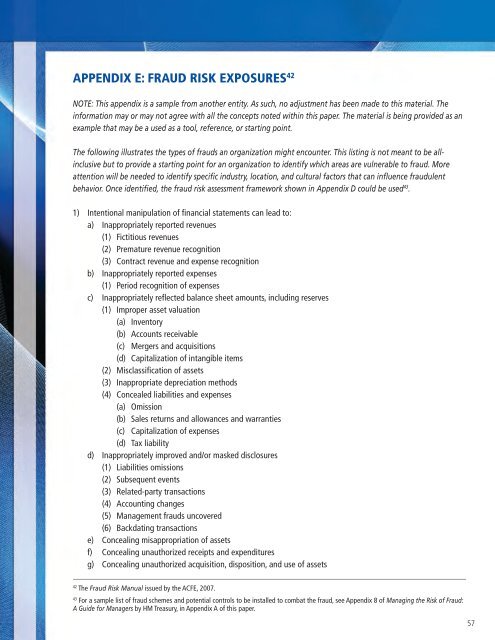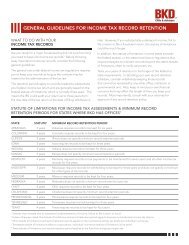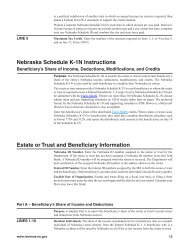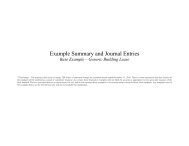acfe fraud prevention check-up - BKD
acfe fraud prevention check-up - BKD
acfe fraud prevention check-up - BKD
- No tags were found...
You also want an ePaper? Increase the reach of your titles
YUMPU automatically turns print PDFs into web optimized ePapers that Google loves.
APPENDIX E: FRAUD RISK EXPOSURES 42NOTE: This appendix is a sample from another entity. As such, no adjustment has been made to this material. Theinformation may or may not agree with all the concepts noted within this paper. The material is being provided as anexample that may be a used as a tool, reference, or starting point.The following illustrates the types of <strong>fraud</strong>s an organization might encounter. This listing is not meant to be allinclusivebut to provide a starting point for an organization to identify which areas are vulnerable to <strong>fraud</strong>. Moreattention will be needed to identify specific industry, location, and cultural factors that can influence <strong>fraud</strong>ulentbehavior. Once identified, the <strong>fraud</strong> risk assessment framework shown in Appendix D could be used 43 .1) Intentional manipulation of financial statements can lead to:a) Inappropriately reported revenues(1) Fictitious revenues(2) Premature revenue recognition(3) Contract revenue and expense recognitionb) Inappropriately reported expenses(1) Period recognition of expensesc) Inappropriately reflected balance sheet amounts, including reserves(1) Improper asset valuation(a) Inventory(b) Accounts receivable(c) Mergers and acquisitions(d) Capitalization of intangible items(2) Misclassification of assets(3) Inappropriate depreciation methods(4) Concealed liabilities and expenses(a) Omission(b) Sales returns and allowances and warranties(c) Capitalization of expenses(d) Tax liabilityd) Inappropriately improved and/or masked disclosures(1) Liabilities omissions(2) Subsequent events(3) Related-party transactions(4) Accounting changes(5) Management <strong>fraud</strong>s uncovered(6) Backdating transactionse) Concealing misappropriation of assetsf) Concealing unauthorized receipts and expendituresg) Concealing unauthorized acquisition, disposition, and use of assets42The Fraud Risk Manual issued by the ACFE, 2007.43For a sample list of <strong>fraud</strong> schemes and potential controls to be installed to combat the <strong>fraud</strong>, see Appendix 8 of Managing the Risk of Fraud:A Guide for Managers by HM Treasury, in Appendix A of this paper.57









